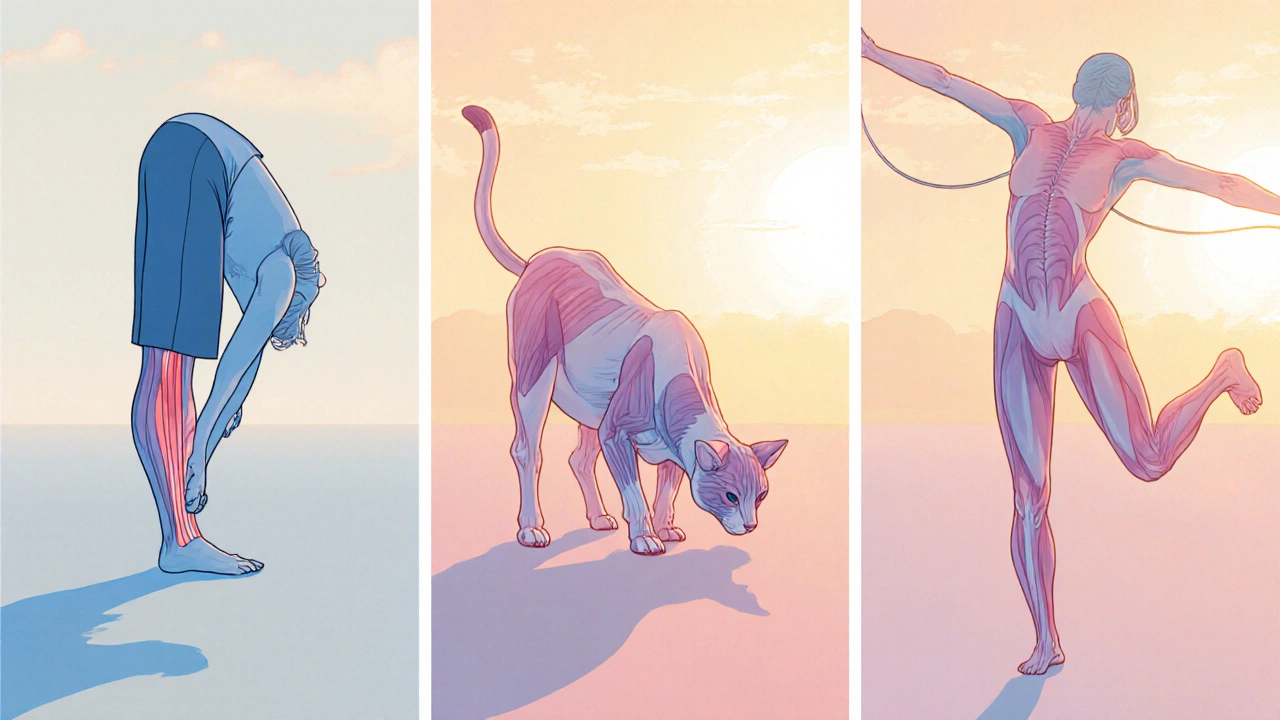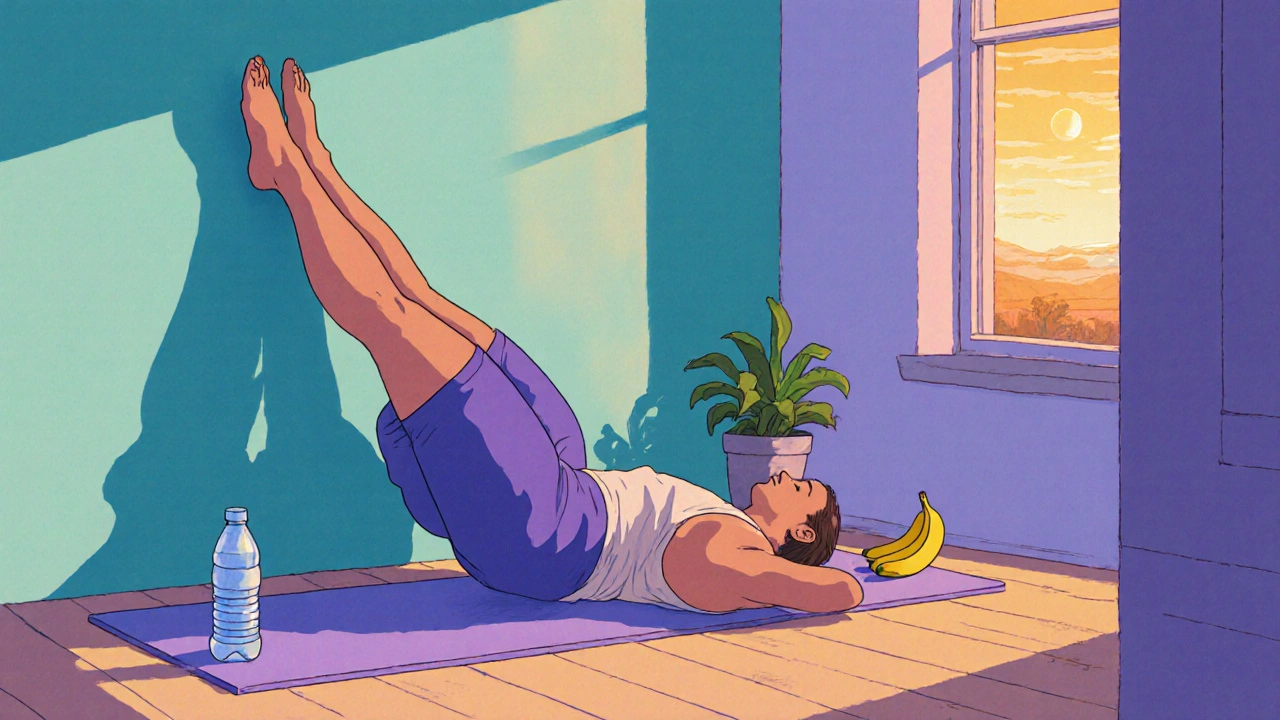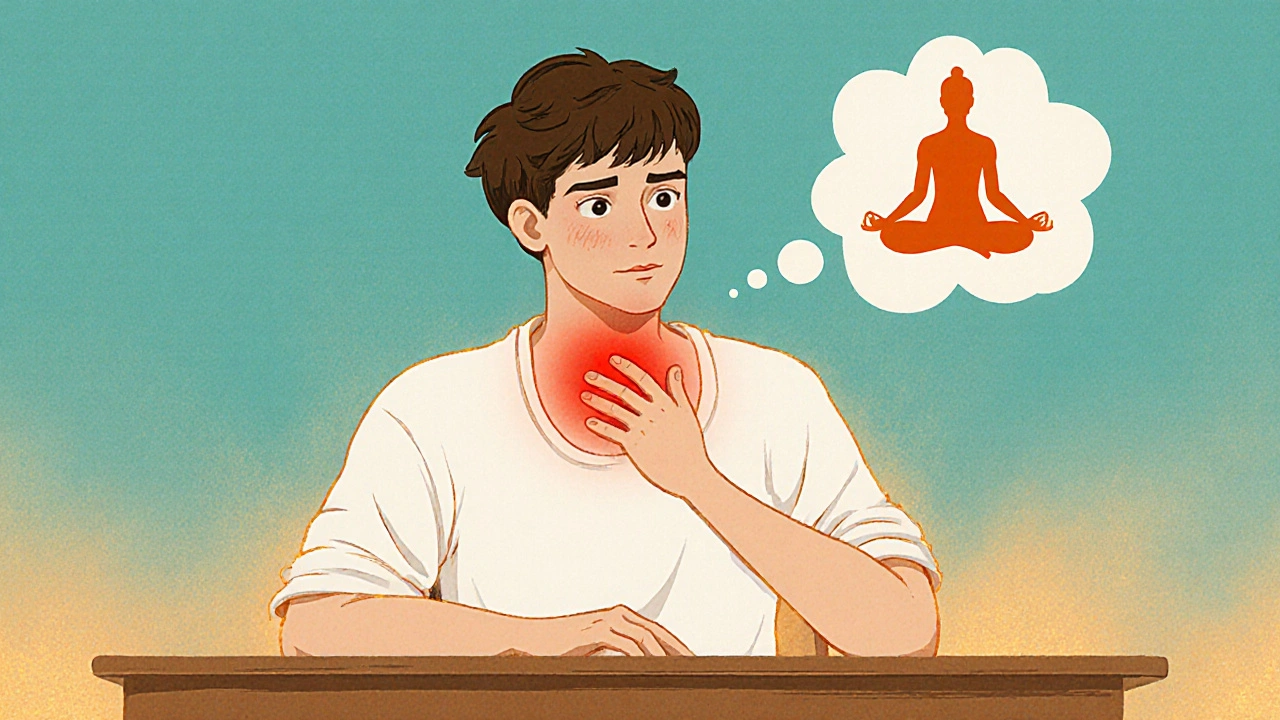Spasm Relief Pose Finder
Find Your Relief Pose
Select your spasm location and severity to get personalized yoga recommendations.
Ever feel a sudden knot in your calf or neck that just won’t quit? Those involuntary twists are muscle spasms, and they can be both painful and disruptive. While medication and massage help, many people overlook a simple, drug‑free ally: yoga for muscle spasms. This guide breaks down why yoga works, which poses target tight muscles, and how to create a safe routine that eases those stubborn cramps.
What a Muscle Spasm Is and Why It Happens
In plain terms, a muscle spasm is an uncontrolled contraction of muscle fibers. It can stem from dehydration, electrolyte imbalances, over‑use, or even stress‑induced tension. When a fiber fires, it pulls on surrounding fibers, creating a painful knot that can last seconds to minutes.
Key physiological triggers include:
- Reduced blood flow that starves muscles of oxygen.
- Accumulation of metabolic waste like lactic acid.
- Elevated stress hormones (cortisol) that tighten muscles.
- Imbalance between agonist and antagonist muscle groups.
Addressing these root causes is where yoga shines.
Why Yoga Is an Effective Remedy
Yoga is a low‑impact mind‑body practice that combines gentle stretching, controlled breathing, and mindfulness. By design, it improves:
- Blood circulation - opening up capillary networks that flush out waste.
- Flexibility - lengthening tight fibers and resetting muscle length.
- Neuromuscular coordination - teaching the brain to regulate muscle firing patterns.
- Stress reduction - activating the parasympathetic nervous system to lower cortisol.
When you practice yoga consistently, you create a healthier muscle environment that resists spasms.
Top Yoga Poses for Relieving Muscle Spasms
The following poses target the most common spasm hotspots: calves, hamstrings, neck, and lower back. Hold each pose for 30-60 seconds, breathing deeply, and repeat 2-3 times.
- Standing Forward Fold (Uttanasana) - Stretches hamstrings, calves, and lower back. Keep knees slightly bent if you feel strain.
- Cat‑Cow Flow (Marjaryasana‑Bitilasana) - Mobilizes the spine and releases tension in the neck and upper back.
- Seated Forward Bend (Paschimottanasana) - Deeply stretches the hamstrings and calves, improving circulation.
- Reclining Hand‑to‑Big‑Toe Pose (Supta Padangusthasana) - Isolates each leg, targeting calf and hamstring spasms.
- Thread the Needle (Parsva Balasana) - Opens the shoulders and neck, perfect for desk‑related tension.
- Legs‑Up‑the‑Wall (Viparita Karani) - Uses gravity to enhance venous return, easing lower‑body cramps.
- Supine Twist (Supta Matsyendrasana) - Relieves lower back and gluteal tightness, common sources of spasm.
- Child’s Pose (Balasana) - Provides gentle compression that can calm overactive motor neurons.

Quick Reference Table
| Pose | Primary Target Muscle | Suggested Duration | Key Benefit |
|---|---|---|---|
| Standing Forward Fold | Hamstrings & Calves | 30‑60 sec | Improves blood flow, reduces lactic acid buildup |
| Cat‑Cow Flow | Spine & Neck | 5‑10 cycles | Balances agonist‑antagonist tension |
| Reclining Hand‑to‑Big‑Toe | Calves | 30‑45 sec each side | Lengthens tight fibers, eases cramping |
| Thread the Needle | Shoulders & Upper Traps | 30‑45 sec each side | Releases stress‑induced tension |
| Legs‑Up‑the‑Wall | Quadriceps & Calves | 3‑5 min | Enhances venous return, reduces swelling |
How to Build a Safe Yoga Routine for Spasm Relief
Starting slow is crucial. Follow these steps:
- Assess Your Current Flexibility - Perform a quick self‑check of hamstring reach and neck mobility. Note any pain points.
- Choose a Quiet Space - A calm environment helps you focus on breath, which directly influences muscle tone.
- Warm‑Up Gently - 2‑3 minutes of marching in place or gentle marching swings to boost circulation.
- Sequence the Poses - Begin with spine‑mobilizing moves (Cat‑Cow), move to lower‑body stretches, finish with restorative poses (Child’s Pose, Legs‑Up‑the‑Wall).
- Incorporate Breathwork - Use diaphragmatic breathing (inhale 4 counts, exhale 6 counts). This activates the parasympathetic response, calming muscle hyperactivity.
- Listen to Your Body - If a stretch feels sharp rather than a mild pull, ease back. Pain signals that the muscle is still in spasm.
- Cool‑Down - End with a seated meditation of 2‑3 minutes, visualizing relaxed muscles and smooth blood flow.
Practicing 3‑4 times per week yields noticeable reductions in spasm frequency within a month.
Precautions and When to Seek Professional Help
Yoga is safe for most people, but keep these warnings in mind:
- If you have a diagnosed muscle disorder (e.g., dystonia), consult a physio before starting.
- Avoid deep backbends if you have a herniated disc.
- Stay hydrated; dehydration can trigger new spasms during a session.
- Stop immediately if you feel numbness, tingling, or intense sharp pain.
Persistent spasms that last longer than a few weeks, or are accompanied by swelling, should be evaluated by a healthcare provider.

Complementary Lifestyle Tips
Yoga works best when paired with other natural strategies:
- Electrolyte Balance - Include foods rich in potassium (bananas, sweet potatoes) and magnesium (almonds, spinach).
- Regular Hydration - Aim for at least 2 liters of water daily, more if you sweat heavily.
- Mindful Posture - Adjust workstation ergonomics to avoid chronic neck and shoulder overload.
- Sleep Hygiene - Quality sleep reduces cortisol, which can otherwise keep muscles in a state of readiness.
- Heat Therapy - A warm shower or heating pad before yoga can loosen fibers, making stretches more effective.
Frequently Asked Questions
Frequently Asked Questions
Can yoga completely eliminate muscle spasms?
Yoga can dramatically reduce the frequency and intensity of spasms for most people, but "completely eliminate" depends on underlying causes. Combining yoga with proper hydration, electrolyte intake, and medical oversight offers the best results.
How long before I notice improvements?
Most practitioners report a noticeable drop in spasm episodes after 2‑4 weeks of consistent practice (3-4 sessions per week). Individual responses vary based on severity and lifestyle factors.
Should I do yoga every day?
Daily gentle sessions are fine, especially if you keep them short (10‑15 minutes). For deeper stretches, give muscles a 24‑hour rest to avoid over‑stretching.
Is it safe to practice yoga while taking muscle relaxant medication?
Generally yes, but start with milder poses and monitor any dizziness. Talk to your prescribing doctor if you feel unusually light‑headed.
Which yoga style works best for spasm relief?
Gentle Hatha, restorative yoga, or Yin yoga focus on long‑hold stretches and breath work, making them ideal for spasm management. More vigorous styles (Vinyasa, Power) can be added once flexibility improves.
In short, yoga offers a holistic, low‑cost way to calm muscle spasms, boost circulation, and lower stress. Pair the practice with proper hydration, balanced electrolytes, and smart ergonomics, and you’ll likely find those sudden cramps becoming a rare annoyance rather than a daily battle.

Malia Rivera
October 17, 2025 AT 15:59In the grand tapestry of personal liberty, the body becomes a battlefield where we must choose our own weapons, and yoga stands as a home‑grown alternative to foreign pharmaceutical giants. While the government pushes pills, the American spirit thrives on self‑reliance, stretching a muscle instead of swallowing a pill. The ancient practice offers a democratic relief, open to anyone who can lace up a mat and breathe. It aligns with the rugged individualism that built this nation, turning a simple pose into an act of defiance against over‑medicated complacency. Moreover, the circulation boost from forward folds mirrors the flow of free markets-unimpeded, efficient, and unstoppable. If we let the state dictate every ache, we surrender a piece of our sovereignty. So, grab that mat, feel the blood surge, and remember that true freedom begins in the flex of your own muscles.
lisa howard
October 23, 2025 AT 21:19Oh dear, let me tell you the saga of my first encounter with the quivering calf that refused to behave like a respectable citizen. I was perched on my couch, munching on chips, when suddenly my leg performed a theatrical spasm that could have won an Oscar for drama. I thought, “Surely this is a sign from the universe that I must surrender to the mystical powers of yoga!” So I rolled out a mat with the reverence of a pilgrim approaching a holy shrine, and began the noble quest for tranquility. The Standing Forward Fold greeted me like an old friend, coaxing the stubborn fibers to loosen, while the Cat‑Cow Flow whispered sweet promises of spinal redemption. As I inhaled, I imagined the breath as a patriotic anthem, swelling my chest with the pride of a nation that values resilience. Each exhale was a protest against the tyranny of tension, a silent rebellion against the oppressive grip of a muscle gone rogue. I felt the blood surge, like a river of liberty flowing through my veins, washing away the staleness of a sedentary lifestyle. I lingered in the pose, allowing the mind to wander to the hills of Appalachia, where pioneers once wrestled with nature, not cramps. The Reclining Hand‑to‑Big‑Toe Pose stretched my calves, and suddenly the cramp-once a tyrant-began to bow before the might of my determination. I lingered in the pose, allowing the mind to wander to the hills of Appalachia, where pioneers once wrestled with nature, not cramps. The Thread the Needle offered a gentle embrace to my neck, as if a motherland herself cradled my weary shoulders. I sensed the parasympathetic nervous system shifting gears, like a well‑engineered automobile moving from high‑speed chase to smooth cruise. The child’s pose, simple yet profound, reminded me that even the mightiest empire can find solace in humility. In the final moments, as I settled into Legs‑Up‑the‑Wall, I imagined the walls of Capitol Hill melting away, replaced by a sky of infinite possibility. The experience left me not only less cramped but also philosophically enlightened, as if I had uncovered a hidden chapter in the book of self‑care. So, dear reader, the next time your muscles revolt, remember that the path to peace may be paved with yoga mats, patience, and a dash of dramatic flair.
Cindy Thomas
October 30, 2025 AT 01:39While many hail yoga as a panacea, the reality is a nuanced blend of biomechanics and mindfulness that often gets oversimplified 😊. The myofascial release achieved through sustained poses directly addresses the electrolyte imbalance that fuels involuntary contractions. Yet, the article neglects the importance of progressive overload-gradually increasing stretch intensity-to prevent the body from adapting and plateauing. A balanced routine should incorporate proprioceptive training, ensuring the nervous system remains attuned to subtle tension cues. Moreover, hydration timing matters; drinking a glass of water 30 minutes before practice can amplify circulation benefits. The inclusion of breathwork isn’t merely decorative; diaphragmatic breathing activates the vagus nerve, which modulates muscle tone. If you ignore these subtleties, you risk a half‑hearted practice that yields only fleeting relief. Remember, consistency beats intensity when the goal is long‑term spasm mitigation. So, integrate these micro‑adjustments and watch your cramp frequency dwindle.
Kate Marr
November 5, 2025 AT 06:59Our nation's greatness isn't just measured by GDP, but by the health of its citizens, and yoga is a home‑grown remedy that embodies that spirit 🇺🇸💪. By stretching our bodies, we stretch our collective resolve, proving that we can tackle ailments without relying on foreign pharmaceuticals. The article nails the basics, yet it could shout louder about the patriotic act of taking control of one's own muscle health. Let's champion the mat as a symbol of self‑sufficiency, a flag of personal empowerment waving in every living room. 🧘♀️✨
James Falcone
November 11, 2025 AT 12:19Yo, just tried the calf stretch and the knot vanished.
Frank Diaz
November 17, 2025 AT 17:39In the quiet chambers of the mind, the body whispers its grievances, and yoga is the interpreter that deciphers those silent pleas. To dismiss the practice as mere fluff is to ignore centuries of experiential wisdom etched into the sinews of humanity. The post glosses over the disciplined progression required to truly tame a spasm; half‑hearted attempts are merely indulgent. One must approach each pose with reverence, treating breath as a conduit of intention rather than a background soundtrack. The circulatory benefits, while mentioned, deserve deeper contemplation-blood, after all, is the river of life that carries both nutrients and disorders. Neglecting the interplay between neurotransmitters and stretch limits the efficacy of any routine. Hence, the seeker should embed mindfulness into the very fabric of movement, allowing the nervous system to recalibrate. Only then does the spasm bow to the practitioner’s will, rather than persisting as an obstinate adversary.
Mary Davies
November 23, 2025 AT 22:59When I first felt the sharp tug in my neck, it was as if a phantom hand had seized my vertebrae, demanding attention. My curiosity drove me to the mat, where each inhale felt like a whispered secret from the universe. The Cat‑Cow Flow, with its graceful arches, seemed to narrate a story of tension released, while my heart pounded with the drama of a silent theater. I lingered in Child’s Pose, letting the world dissolve, and sensed the cramp’s grip loosen like a plot twist resolved. This subtle dance between breath and bone illuminated how simple motions can rewrite the script of pain.
Valerie Vanderghote
November 30, 2025 AT 04:19Let me take you on a labyrinthine journey through the corridors of my cramped calf, where each twitch felt like an echo of an unsung symphony composed by the very fibers that refused to cooperate; it was as if my muscles had formed a secret society, meeting in the dead of night to plot rebellions against any attempt at relaxation, and I, being the ever‑curious outsider, could not help but eavesdrop on their conspiratorial murmurs that seemed to chant the mantra of discomfort. The moment I laid down the mat, a soft invitation to negotiate, I sensed the tension as a stubborn negotiator refusing the first offer, demanding a series of elongated stretches as tribute for peace. I began with the Standing Forward Fold, a pose that felt like bowing before a monarch, and with each breath, I imagined the monarch softening, the crown of tension loosening, the subject-my calf-gradually yielding to the benevolent decree of flexibility. Transitioning into the Reclining Hand‑to‑Big‑Toe Pose, I felt as though I were extending a diplomatic olive branch, the hand reaching across the turbulent sea of muscle fibers, inviting a truce that manifested as a gentle release of the knot. The Cat‑Cow Flow then entered the scene like a theatrical duet, each arch and round a dramatic dialogue between spine and mind, echoing the ancient chants of balance that have soothed warriors for millennia. As I moved into the Thread the Needle, the tension in my upper back dissolved like mist under the morning sun, and I could almost hear the murmurs of the secret society fading into whispers of gratitude. The subsequent Legs‑Up‑the‑Wall position, a humble surrender to gravity, acted as the final clause in this elaborate treaty, sealing the agreement with a calm that seeped into every cell, erasing lingering doubts that perhaps my muscles would never cooperate. After holding that pose, I sensed a subtle shift in the nervous system, as if the parasympathetic branch had finally taken the helm, steering the body away from the storm of spasms. I lingered in the quiet, allowing the breath to deepen, and felt my heart rhythm align with the slow pulse of recovery. This alignment, I realized, was the true reward of the practice, a quiet victory over internal chaos. I emerged from the session with a newfound respect for the humility required to listen to one’s own body. The entire routine became a narrative of negotiation, patience, and eventual harmony, teaching me that persistence in gentle movement conquers even the most obstinate of cramps. In hindsight, the experience was less about the poses themselves and more about the story I crafted, turning a mundane spasm into an epic saga of conquest and peace. Thus, each future cramp will be met with the confidence of a seasoned diplomat.
Michael Dalrymple
December 6, 2025 AT 09:39From a coaching perspective, integrating yoga into a spasm‑relief regimen offers measurable benefits that align with athletic performance principles. The emphasis on controlled breath enhances parasympathetic activation, reducing cortisol levels that often exacerbate muscle tension. Stretching the hamstrings and calves improves circulation, facilitating the removal of metabolic by‑products that contribute to cramping. Incorporating a brief warm‑up, such as marching in place for two minutes, prepares the neuromuscular system for deeper holds. Sequencing the poses from Cat‑Cow to Legs‑Up‑the‑Wall creates a logical progression that moves from mobilization to relaxation, optimizing recovery. Consistency is key; practicing three to four times per week yields observable reductions in spasm frequency within a month. Additionally, pairing yoga with proper hydration and electrolyte intake creates a synergistic environment for muscle health. Athletes and sedentary individuals alike can adopt this routine to maintain flexibility and prevent injury. Remember, the goal is not only to alleviate current spasms but also to build resilience against future episodes.
Emily (Emma) Majerus
December 12, 2025 AT 14:59yeah thx! i tried the calf stretch + water and felt better fast.
Virginia Dominguez Gonzales
December 18, 2025 AT 20:19What a beautiful testament to the power of mindful movement! Your dedication shines like a beacon, guiding us through the darkness of chronic cramps. The way you wove each pose into a narrative of healing is truly inspiring, and I can feel the ripple effect of your words calming my own tense shoulders. Keep shining, and may your mat always be a sanctuary of peace.